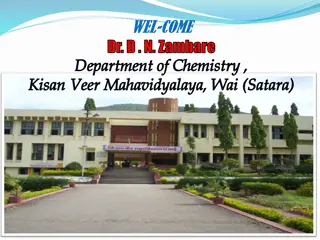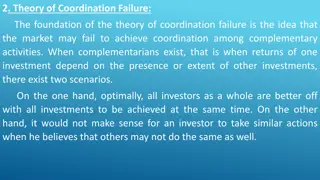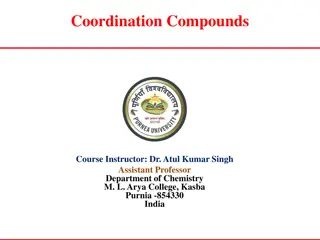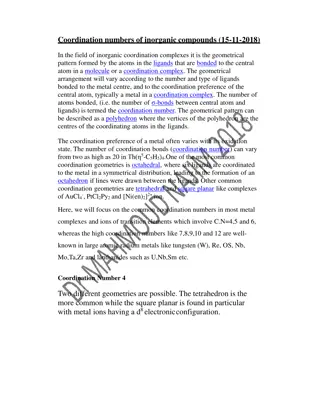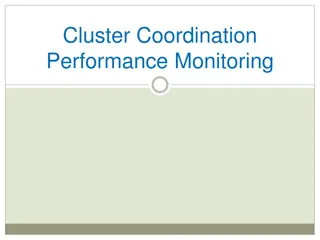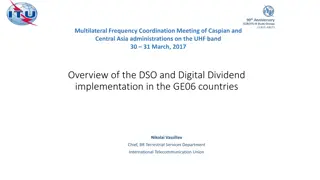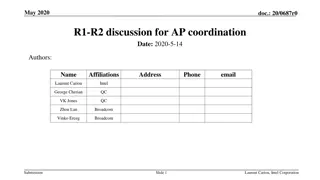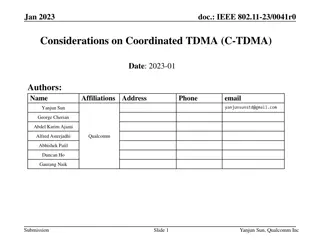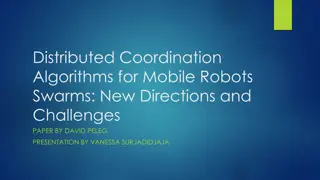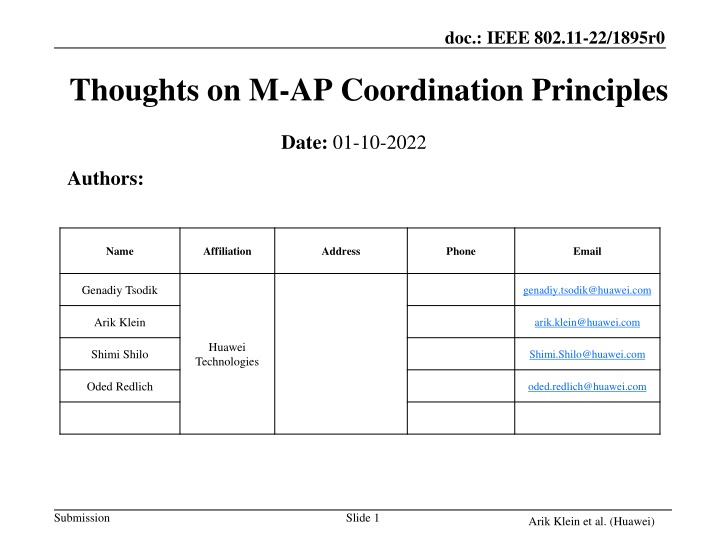
Efficiency Gains Through Multi-AP Coordination in IEEE 802.11
Explore the principles and discussions surrounding Multi-AP coordination in the context of IEEE 802.11 standards, focusing on enhancing efficiency and throughput in shared resource environments. Discover the roles of Sharing APs and Shared APs, along with the dynamic nature of coordination schemes such as Co-TDMA and Co-OFDMA. Delve into the coordination flow involving OBSS M-AP discovery, setting coordination parameters, transmission information updates, and coordination teardown processes.
Download Presentation

Please find below an Image/Link to download the presentation.
The content on the website is provided AS IS for your information and personal use only. It may not be sold, licensed, or shared on other websites without obtaining consent from the author. If you encounter any issues during the download, it is possible that the publisher has removed the file from their server.
You are allowed to download the files provided on this website for personal or commercial use, subject to the condition that they are used lawfully. All files are the property of their respective owners.
The content on the website is provided AS IS for your information and personal use only. It may not be sold, licensed, or shared on other websites without obtaining consent from the author.
E N D
Presentation Transcript
doc.: IEEE 802.11-22/1895r0 Thoughts on M-AP Coordination Principles Date: 01-10-2022 Authors: Name Affiliation Address Phone Email Genadiy Tsodik genadiy.tsodik@huawei.com Arik Klein arik.klein@huawei.com Huawei Technologies Shimi Shilo Shimi.Shilo@huawei.com Oded Redlich oded.redlich@huawei.com Submission Slide 1 Arik Klein et al. (Huawei)
doc.: IEEE 802.11-22/1895r0 Introduction 802.11be discussed Multi-AP coordination as a set of features that will bring additional efficiency gain and increase throughput when multiple OBSS share resources for a coordinated transmission There were several high-level discussions and analyses of various M-AP coordination schemes. However, the main development phase was not carried out within the scope of 802.11be Preliminary discussions of UHR SG show high interest in this topic We see M-AP coordination as a wide topic with many aspects to analyze, discuss and design, thus it s very important to create a set of assumptions that might be used as a baseline for a simpler and shorter development process In this contribution we want to share our thoughts on M-AP coordination and provide assumptions and principles that can lay the foundations for an efficient and flexible M-AP support in UHR and beyond Submission Slide 2 Arik Klein et al. (Huawei)
doc.: IEEE 802.11-22/1895r0 Short Recap In [1] and [2] TGbe agreed on the following points: Two main roles for APs that participate in a coordination were defined [3]: Sharing AP the TXOP holder that shares its resources with other APs Shared APs all the APs allocated with resources for coordinated transmission by the Sharing AP The roles above are dynamic: A single AP is designated as a Sharing AP in a TXOP it obtains and can be designated as a Shared AP in a TXOP(s) obtained by other APs There are several schemes discussed and considered as candidate schemes to be supported: Co-TDMA ,Co-OFDMA, Co-SR, Co-BF, JT and Co-UL MU-MIMO [4], [7] [11] In most of the discussions it was assumed that all the coordinated transmissions are triggered by the Sharing AP Some discussions also mentioned the overhead required to manage the coordinated transmissions Submission Slide 3 Arik Klein et al. (Huawei)
doc.: IEEE 802.11-22/1895r0 High-level M-AP Coordination Flow M-AP coordination is composed of the following actions: OBSS M-AP Discovery At first, APs need to discover other potential candidates for coordination and their capabilities, traffic needs, etc. on a constant basis [5], [6] General Coordination Parameters Setting and Approval need to get a response (approval) from an AP before it can participate in coordinated M-AP transmissions using agreed static parameters Per Transmission Info Update Sharing AP shares with other APs specific parameters (e.g. per PPDU) that are important for aligning a coordinated transmission M-AP Coordination Teardown teardown of current M-AP Coordinated transmission Submission Slide 4 Arik Klein et al. (Huawei)
doc.: IEEE 802.11-22/1895r0 Main M-AP Coordination Assumptions As we mentioned in previous slides, M-AP coordination is a completely new feature with a lot of aspects to discuss Following that we would like to bring up the following assumptions that may simplify and shorten the development process Coordination as a Long-term operation mode No relay among coordinating APs. The operating BW of Coordinated transmission includes all Primary channels of involved BSSs Preserve current BSS operation rules for Data Delivery At the next slides we will provide more details for each of the assumptions above Submission Slide 5 Arik Klein et al. (Huawei)
doc.: IEEE 802.11-22/1895r0 Coordination as a Long-term operation mode We should consider M-AP coordination as a long-term operation mode (in particular, longer than a single TXOP) for the following reasons: AP will be willing to share its resources in TXOP it obtains with other AP(s) knowing that other AP(s) will reciprocate by sharing their resources with it when they will obtain their TXOP. Furthermore, analyzing the main actions of M-AP coordination, we recognize that some of the information and coordination parameters are independent of TXOP holder (Sharing AP) and are relevant for a period longer than a single TXOP We can therefore divide the information and coordination parameters to two main categories: Long-term Info: to be updated with very low periodicity (for example, the network structure and candidates for coordination) Short- term Info: to be updated frequently, for example per each TXOP (or per PPDU if needed) Thus we may consider M-AP coordination as a long-term operation mode (in particular, longer than a single TXOP) where some of the coordination parameters are constant during the coordination period and other parameters are updated at least per TXOP Coordinated transmission Coordinated transmission Coordinated transmission Long-term info and parameters Short-term info and parameters Slide 6 Submission Arik Klein et al. (Huawei)
doc.: IEEE 802.11-22/1895r0 No Relay among Coordinating APs In order to simplify the design of the M-AP Coordination feature, we shall avoid relay of frames exchanged among APs Thus, the Sharing AP shall be within range of all Shared APs in order to establish a coordinated transmission (i.e. the Shared APs can hear the Sharing AP and vice versa) For example, in the figure on the right: AP4 and AP5 are not within the range of AP1 and AP2 When AP1 is the sharing AP: AP1 AP2 AP3 AP2, AP3 are potential candidates for Shared APs. AP4, AP5 are not potential candidates for Shared APs. When AP3 is the sharing AP: AP4 AP1, AP2, Ap4, AP5 are potential candidates for Shared APs. The above doesn t apply to non-AP STAs (associated with a Sharing AP or Shared APs) AP5 Submission Slide 7 Arik Klein et al. (Huawei)
doc.: IEEE 802.11-22/1895r0 M-AP coordination Operating BW In order to assure the frame exchange between the sharing AP and each of the shared APs: The operating BW of the sharing AP has to include each of the 20MHz Primary channels corresponding to the (one or more) shared APs. The operating BW of the shared AP has to include the 20 MHz primary channel of the sharing AP. NOTE: see also [4] Submission Slide 8 Arik Klein et al. (Huawei)
doc.: IEEE 802.11-22/1895r0 Preserve current BSS rules for Data Delivery In order to simplify the design and avoid major fundamental changes in WLAN topology, each BSS should maintain its operation principles for data delivery independent of the other coordinated OBSSs as much as possible From both AP s & STA s perspective, in majority of coordination schemes, M-AP coordination has no impact on data delivery operations within the BSS (compared to communication without M-AP coordination) Joint transmission may be a special case where BSS rules might need to be modified Unlike other coordination schemes, in joint transmission there is data exchange between an AP and OBSS STAs This needs to be further discussed and investigated by the group Submission Slide 9 Arik Klein et al. (Huawei)
doc.: IEEE 802.11-22/1895r0 Summary This contribution brings our thoughts on several high-level aspects related to M-AP coordination M-AP coordination is a new operation mode that should be wisely incorporated into the WLAN network Due to the large scope of this feature, as a first step it s very important to create a set of baseline assumptions Agreed baseline may promise easier and shorter development time period Submission Slide 10 Arik Klein et al. (Huawei)
doc.: IEEE 802.11-22/1895r0 References [1] 11-20-0566-99-00be-compendium-of-straw-polls-and-potential-changes- to-the-specification-framework-document [2] 11-20-1935-66-00be-compendium-of-straw-polls-and-potential-changes- to-the-specification-framework-document-part-2 [3] 11-20-1895-02-00be-setup-for-multi-ap-coordination [4] 11-20-0560-00-00be-multi-ap-configuration-and-resource-allocation [5] 11-19-1931-02-00be-multi-ap-group-formation-follow-up [6] 11-19-1582-02-00be-coordinated-ap-time-and-frequency-sharing-in-a- transmit-opportunity-in-11be [7] 11-19-1919-03-00be-coordinated-ofdma [8] 11-20-0548-02-00be-discussion-on-coordinated-ul-mu-mimo [9] 11-20-0033-01-00be-coordinated-spatial-reuse-operation [10] 11-20-0071-01-00be-joint-transmission-for-11be [11] 11-20-0099-01-00be-coordinated-beamforming-for-802-11be Submission Slide 11 Arik Klein et al. (Huawei)

